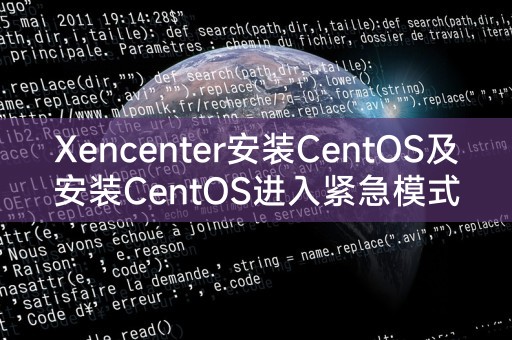
php editor Baicao brings you solutions for installing CentOS in Xencenter and entering emergency mode when installing CentOS. Xencenter is a powerful virtualization management tool, and CentOS is a commonly used Linux operating system. The combination of the two can provide users with a better virtualization experience. However, you may encounter some problems during the installation of CentOS, such as entering emergency mode. This article will introduce you in detail how to correctly install CentOS and how to solve the problem of entering emergency mode, helping you to successfully complete the installation and use.

#1. Make sure you have installed Xencenter and created a virtual machine instance.
2. Open Xencenter and select the virtual machine instance where you want to install CentOS.
3. Click the "Console" option in the menu bar to open the virtual machine's console.
4. In the console, click "Virtual Optical Disk", then select "Mount Disk" and select the CentOS ISO image file.
5. Restart the virtual machine and follow the instructions of the CentOS installation wizard to install.
6. During the installation process, you can choose the version of CentOS to install, partition settings, network settings, etc.
7. After completing the installation, restart the virtual machine. You can now use the CentOS operating system.
Sometimes, when installing or starting CentOS, you may encounter an "Entering emergency mode" error message, which means that the system cannot start normally and enters emergency mode. Here are some solutions:
1. Check whether the hard disk or file system is damaged. You can use the command "fsck" to check and repair file system errors.
2. Check whether the boot configuration is correct. You can use the command "grub2-mkconfig" to regenerate the boot configuration file.
3. Check whether the boot loader is installed correctly. You can use the command "grub2-install" to reinstall the boot loader.
4. Check the system log for more error information. You can use the command "journalctl -xb" to view the system log.
5. If none of the above methods work, you can try to boot from the CentOS installation media and select repair mode.
6. If the problem persists, it is recommended to reinstall the CentOS operating system.
In Linux, use the command "df -h" to view the file system usage. This command will display the total capacity, used space, free space and usage rate of each file system, which is useful for monitoring Disk space usage is very helpful.
Xencenter, CentOS, installation, entering emergency mode, system failure, file system, disk space
The above is the detailed content of Solutions for installing CentOS in Xencenter and entering emergency mode after installing CentOS. For more information, please follow other related articles on the PHP Chinese website!
 attributeusage
attributeusage
 Website domain name valuation tool
Website domain name valuation tool
 What are the cloud servers?
What are the cloud servers?
 How to solve the problem of missing steam_api.dll
How to solve the problem of missing steam_api.dll
 Ethereum browser query digital currency
Ethereum browser query digital currency
 The main components that make up the CPU
The main components that make up the CPU
 What are the java file transfer methods?
What are the java file transfer methods?
 How to set the computer to automatically connect to WiFi
How to set the computer to automatically connect to WiFi
 Is Bitcoin trading allowed in China?
Is Bitcoin trading allowed in China?




